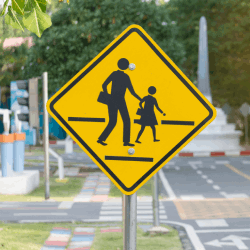As most of its residents know, New Jersey is the most densely populated state in the country. People and cars are everywhere. Unfortunately, the two collide all too often and the outcome of a pedestrian-car accident can be catastrophic. If you have been injured as a pedestrian, you will want to find out the extent to which you can be compensated, not only for medical bills and lost wages, but also for pain and suffering, or mental anguish. This article outlines everything you need to consider if you (or someone you love) has been hit by a vehicle.
What Are the Causes of These Pedestrian-Car Accidents?
Like most car accidents in general, pedestrians are hit as a result of negligence. In some cases, drivers do not obey rules and regulations of the road. For example, they may not yield to a pedestrian in a crosswalk. Other causes include distracted drivers (and/or pedestrians) who may be texting on cell phones, speeding, people driving under the influence of alcohol or drugs, and poor visibility (driving at night or in bad weather).
Where do these accidents occur? The answer is pretty much everywhere, but pedestrians are often hit outside of designated crosswalks, at crosswalk areas, and in parking lots. People are also injured when drivers lose control, jumping a curb and striking someone on the sidewalk, for example.
What’s Expected of Drivers and Pedestrians?
Both drivers and pedestrians have responsibilities. An experienced NJ personal injury lawyer will investigate to determine who is at fault in an accident. Generally speaking, drivers must always stop for pedestrians at crosswalks, corners, and any other areas marked for pedestrians. They also need to stop and look both ways before making turns.
Pedestrians are expected to look both ways before crossing a street, use designated crosswalks, and step off the curb only when crosswalk lights indicate that it’s safe for them to do so. When someone walks into or crosses a street that has traffic, other than at a marked crosswalk, or otherwise disregards traffic rules, they are known as jaywalkers.
New Jersey’s Right-of-Way Laws Can Affect Claims
New Jersey Statute 39:4-36 lays out exactly what is expected of drivers and pedestrians.
Drivers: The law states that a driver “must stop and stay stopped for a pedestrian crossing the roadway within any marked crosswalk,” and must “yield the right-of-way to a pedestrian crossing the roadway within an unmarked crosswalk at an intersection, except at crosswalks when the movement of traffic is being regulated by police officers or traffic control signals, or where otherwise prohibited by a…regulation, and except where a pedestrian tunnel or overhead pedestrian crossing has been provided.”
Pedestrians: A pedestrian cannot “suddenly leave a curb or other place of safety and walk or run into the path of a vehicle which is so close that it is impossible for the driver to yield.” Additionally, “every pedestrian upon a roadway at any point other than within a marked crosswalk or within an unmarked crosswalk at an intersection shall yield the right-of-way to vehicles.”
But even if a driver has right of way, they may still be liable for running over a pedestrian. In Leighton v. Sim, a driver struck a pedestrian who was crossing a road 200 feet from a crosswalk at night. Although the pedestrian was not using the crosswalk, the evidence showed that the driver should have been able to see the pedestrian from 150 feet away and stop well before hitting her. Accordingly, the Appellate Division of the Superior court ruled that the driver could be held liable.
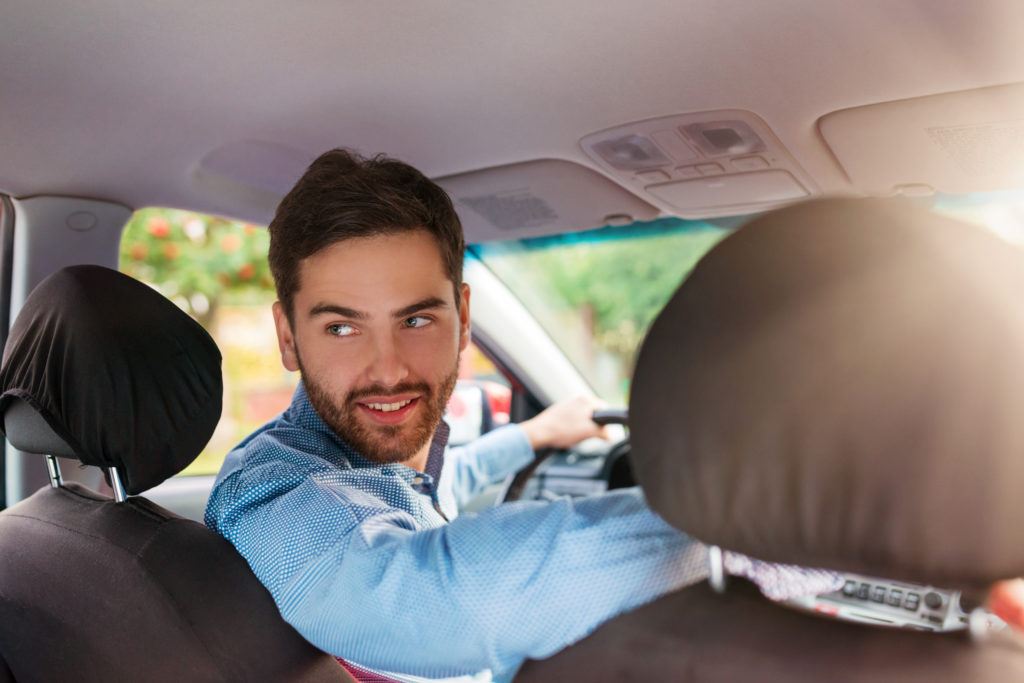
Who Has Right of Way in a Parking Lot?
It’s not at all uncommon for people to be hit by cars in parking lots and garages, especially during holiday seasons. According to an article by Robson Forensic citing a 2017 report by the Institute of Transportation Engineers (ITE), “Pedestrian and Bicycle Safety in Parking Facilities,” 480 pedestrian-car crashes occurred in parking facilities over a 3-year period in 45 New Jersey towns.
Like roadways, parking lots may also have designated pedestrian crossing, as well as clearly marked parking spaces, lanes, and signs. Generally, cars have right-of-way in lanes but drivers must obey signs and yield to people already walking across a lane in designated crossing areas. When backing out of parking spaces, drivers must take care to not hit a pedestrian (or another car driving through the lane).
After the Accident: What Should You Do?
If you are not seriously injured and are physically able, there are some things you will want to do at the accident scene if you are hit by a car. Understandably, you will be shaken but try to remain as calm and focused as possible.
- Call for help (police, ambulance). The police will write up a report on the accident.
- If you have a cell phone (or happen to have a camera), take pictures.
- Your memory of the accident may fade over time so jot down notes, recording things like where the accident occurred, date and time, driver’s name, and license plate number of the vehicle involved.
- Look for eyewitnesses. If you find any, get their name and contact information.
- Seek medical attention. Even if you don’t need an ambulance, you should see a doctor as soon as possible. You will want to have medical documentation of your injuries.
- Reach out to an experienced law firm. A personal injury attorney will gather other evidence (like security camera footage from nearby buildings), interview any eyewitnesses, and help to establish fault for the accident.
Note that the statute of limitations for personal injury claims in New Jersey is two years from the date of your accident. If you wait any longer than two years, you will most likely be unable to pursue legal action against the party responsible.
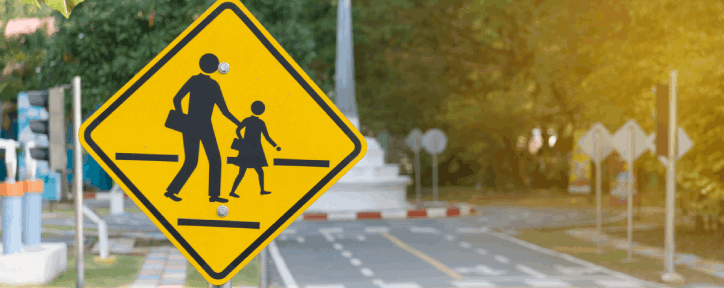
Proving Who Is at Fault/Negligent
If a driver runs afoul of New Jersey state law, they are subject to one or more of the following:
- A $200 fine (plus court costs)
- 2 points on their driver’s license
- 15 days of community service
- An increase in their car insurance rate
A driver who is responsible for a pedestrian car accident will likely be ticketed as well.
Just like drivers, pedestrians can be at fault in an accident. For example, they may be distracted (by texting) or under the influence of drugs or alcohol. A pedestrian hit by a car will have to prove the driver (and not them) was to blame in order to collect insurance money for damages.
In some cases, negligence is so obvious that the driver has the burden of proving they were not at fault. In Mangual v. Berezinsky, a driver on a highway swerved and struck two people standing on the shoulder of the road. The Appellate Division of the Superior Court held that the driver was automatically liable for the accident unless he could prove some circumstance beyond his control caused the accident.
This is why it’s important to have photographic evidence, witness statements, and police reports. If the driver is at fault, this evidence will support your case. For example, a police report may find that the driver committed a traffic violation like failing to yield at a crosswalk. Or, perhaps the driver was ticketed for a DUI (driving under the influence). Observations from police at the scene can carry a good deal of weight if your lawyer is representing you against an insurance company.
A lawyer can use the discovery process in a lawsuit to find additional evidence that the driver was at fault. In Kaminski v. Mayer, an 80-year-old woman ran over a pedestrian, severely injuring the pedestrian. The woman normally had an aide drive her to her doctors’ appointments during the week, and the court allowed the pedestrian to use this evidence to prove the woman knew she wasn’t able to drive safely. Ultimately, the pedestrian won a verdict for $2,320,000.
It’s important to note that other factors could contribute to other parties being held liable for an accident. For example, the vehicle may have a defective part that caused the crash, or a non-functioning traffic signal may be the reason a car did not yield or stop.
Hit-and-Run Car Accidents
Proving fault and knowing what insurance company to pursue for a settlement is a complicated matter in hit-and-run accidents. It is illegal for drivers to leave the scene of an accident. In New Jersey, hit-and-run drivers may face steep fines, license suspension, even jail time. You would think that these potential penalties would be enough to discourage drivers from fleeing a crash, but it does happen.
First, you want to try and track down the person driving. This is where a personal injury lawyer can assist by finding and reviewing security video footage and speaking to potential witnesses. Second, you will need to establish fault without the benefit of things like photos of the car’s location and damage immediately after the accident, and the state of the driver. An attorney may be able to trace the whereabouts of the driver immediately before the crash, which can prove valuable if, for example, the driver spent two hours at a bar beforehand.
It’s unfortunate, but sometimes a hit-and-run driver is never located. There will be no defendant and no insurance company to pursue for compensation. In these cases, a lawyer can help identify alternate sources of coverage. Most likely, a claim will need to be filed with the pedestrian’s own insurance company.

Case Study: $3.9 Million
What makes this case unique: Competing arguments on whether the victim had experienced “impending doom”; a big-shot attorney who was “too large” for the case.
What If Someone You Love Is Struck and Killed by a Car?
Sadly, pedestrian-car accidents can result in death. The map below shows the breakdown of pedestrian fatalities by New Jersey county.
An at-fault driver who causes the death of a pedestrian after a car accident may face a wrongful death lawsuit. Just as you need to prove your case in non-fatal accidents, this kind of claim will also need to establish the driver’s negligence in causing the accident. An attorney will gather the evidence needed to get a settlement for family members of the deceased. Among the things that can be compensated for include funeral expenses, wages the deceased would have earned, and lost companionship. The goal of an experienced lawyer is to attain financial security for the victim’s surviving loved ones.
In 2018 (the most recent year this data is available), the National Highway Traffic Safety Administration (NHTSA) recorded 173 pedestrian deaths in New Jersey. This number represents 31% of all fatalities involving car accidents that year.
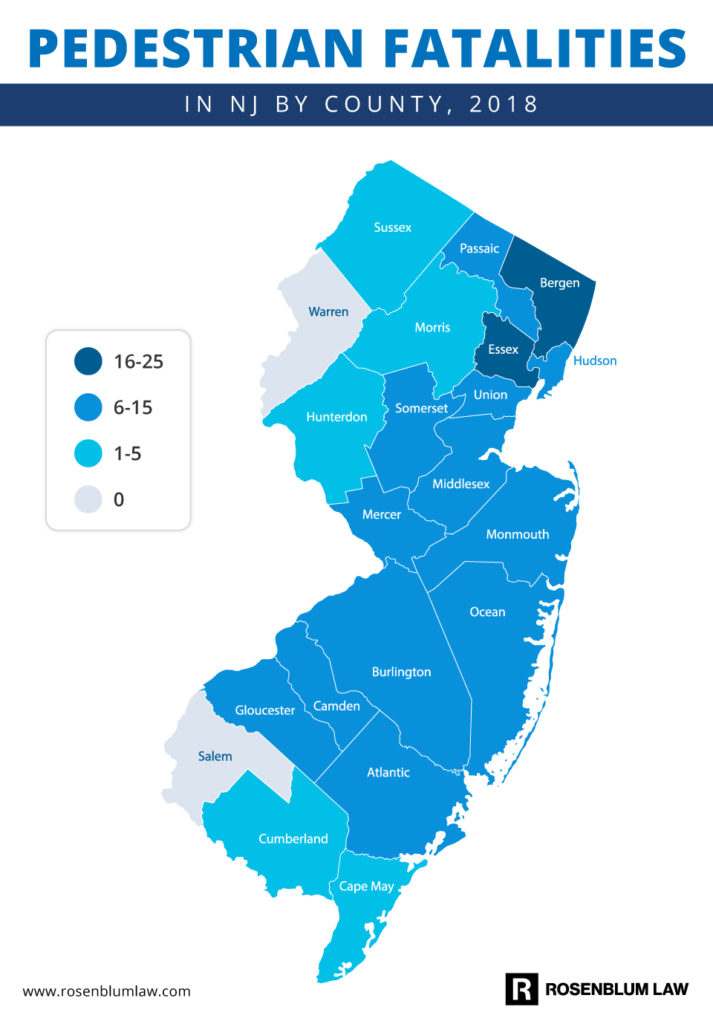
An experienced lawyer will help you weigh the pros and cons of accepting an insurance settlement amount versus going to trial. How long would it take to litigate and how much would it cost in legal fees? What are the chances you will even win in court?
In practice, most pedestrian-car accident claims are settled through the driver’s car insurance, typically by way of an out-of-court settlement. New Jersey requires all drivers to carry car insurance to make sure victims can be compensated. Moreover, all car insurance policies must include coverage for Personal Injury Protection (PIP), sometimes called Medical Expense Benefits (MEB) to cover medical bills.
If multiple cars are involved in the accident, a pedestrian may be able to get settlements from more than one insurance company. In Lumpkins v. Market Transition Facility of New Jersey, a pedestrian was injured when one car rear-ended another, causing the front car to hit the pedestrian. New Jersey law requires car insurers to pay out PIP benefits any time a car they insure causes bodily injury to a pedestrian or any time a pedestrian is injured by an object propelled by a car. The court interpreted this requirement to mean both insurance companies had to cover the pedestrian’s injuries because one car propelled the other into the pedestrian, so both cars caused personal injury to the pedestrian
What if the driver who injured a pedestrian did not comply with New Jersey law and was uninsured at the time of the accident? As in the case of hit-and-run crashes, it’s likely your attorney will need to pursue a claim with your own insurance company.
Settlement Amounts
PIP benefits only cover what the law calls economic damages such as medical bills and wages lost because the injured person cannot work. They do not cover pain and suffering, loss of enjoyment of life, or other, non-economic types of damage. Moreover, PIP benefits have policy limits with the required minimum being only $15,000.
You will want an experienced personal injury lawyer working on your behalf if:
- the driver’s insurance denies these PIP benefits,
- your medical costs exceed the PIP policy limit, and/or
- you want to recover the less quantifiable (non-economic) damages from the party at fault.
Settlements are binding legal agreements, and accepting a settlement forfeits the right to sue. If the settlement turns out not to be enough, there is no way to get more compensation. A lawyer can evaluate the settlement and circumstances of the accident to make sure that the injured person is getting all the money they deserve. The same applies to loved ones of a pedestrian who dies from such an accident.
For example, in Aarons v. Aponte, the parents of a pedestrian killed in a car accident sued the driver. The parents accepted a settlement for $100,000. Later, they attempted to repudiate the settlement and bring a lawsuit against the driver. However, the Appellate Division of the Superior Court did not allow the lawsuit to proceed because the parents could not prove they were coerced into the settlement.
When it comes to considering fault in pedestrian car accidents, it’s important to remember that the driver is not always 100% responsible. New Jersey requires pedestrians to follow the right-of-way laws. If the pedestrian is at least partially to blame for the accident (by darting out into the road outside of a crosswalk, distracted by texting, or impaired by drugs or alcohol, for example), insurance companies will lower the award offered. If the settlement was calculated to be $100,000, but it was determined that the pedestrian was 30% responsible for the accident, the final amount will be reduced to $70,000.
Generally, the more severe the injuries, the more a pedestrian can expect to be compensated through insurance company settlements.
Statistics for Non-Fatal Pedestrian Accidents in New Jersey
Most pedestrian-car accidents in New Jersey are not fatal but that doesn’t mean that injuries caused by them aren’t serious. Yes; some lucky people may sustain only cuts and bruises if struck by a car barely moving. Unfortunately, a person hit by a vehicle can also suffer moderate or significant injuries, perhaps even permanent and life-altering ones. Common pedestrian injuries include:
- Bone fractures
- Brain injuries
- Spinal cord injuries
- Disfiguring lacerations
- Loss of a limb
- Organ damage
According to a State of New Jersey Highway Safety Plan report filed with the NHTSA, about 4,000 people a year are injured by vehicles in this state. The table below shows the most recent data available by severity of injuries in pedestrian-car accidents.
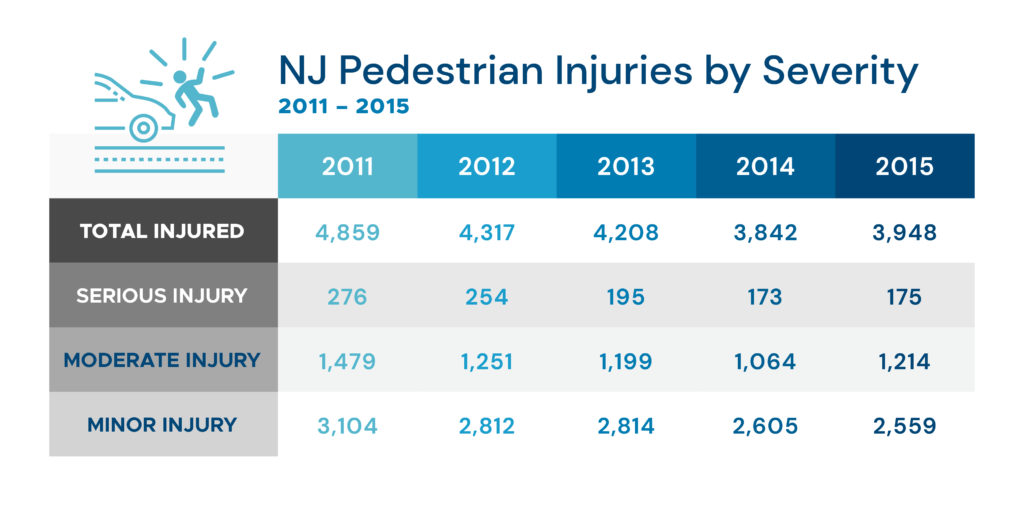
Going to Trial
As mentioned earlier, most pedestrian-car accident claims are settled before going to trial. If an agreement cannot be reached, a case will go to trial. This process will take longer and likely cost more money to pursue. You will want to consult with an experienced personal injury attorney to weigh your options. Together, you can discuss the chances of winning, and if the amount likely awarded will offset the extra time and money it took to go to court. If you do proceed to trial, your lawyer will be prepared to present your case to a jury.
Frequently Asked Questions
Yes; a pedestrian can sue an at-fault driver for economic damages (medical bills and lost wages) and perhaps even non-economic damages like pain and suffering.
Although driver’s in New Jersey are required to carry insurance, not everyone obeys the law. In these situations, a lawyer will most likely pursue a claim with the pedestrian’s own insurance company.
The amount will vary based on the severity of injuries and degree of fault in the accident. Settlements should cover medical expenses, lost wages, and maybe even non-economic damages (pain and suffering).
Drivers are required by law to yield for pedestrians but New Jersey assigns responsibilities to pedestrians as well. The driver may be 100% in the wrong, or both driver and pedestrian can have some fault. An experienced personal injury lawyer will help to establish which party is to blame, and to what extent.
In New Jersey, a driver who hits a pedestrian will get points on his/her license (or have it suspended), may have to do community service, and will pay fines. If the pedestrian is killed and the driver was drunk at the time of the accident, a charge of vehicular homicide and jail time are likely.
Who Should I Contact About My Pedestrian Accident Injuries?
If you or someone you love has been injured or killed in a pedestrian accident, contact the attorneys at Rosenblum Law. Our experienced and skilled attorneys have won many cases with positive results. To speak directly to one of our attorneys, call 888-235-9021 or email us today.
